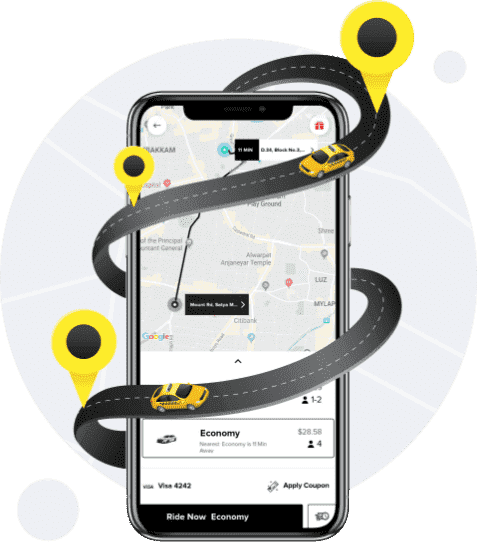How Are AI Algorithms Improving Routing and Dispatch in Uber-Like Apps?

The incorporation of artificial intelligence (AI) into numerous elements of technology and daily life has transformed several sectors, with the ride-hailing industry being a prime example. Uber-like apps have used AI algorithms to improve routing and dispatch operations, resulting in considerable increases in efficiency, cost-effectiveness, and user pleasure. This in-depth investigation digs into how AI algorithms are enhancing routing and dispatch in Uber-like apps, providing insights into the processes, advantages, problems, and future possibilities of these developments. For businesses aiming to develop an app like Uber, leveraging AI technology is crucial for staying competitive and meeting user expectations.
Introduction to AI in Ride-Hailing Apps
AI has become a cornerstone in the development of intelligent systems that can learn from data, make decisions, and improve over time. In the context of ride-hailing apps, AI algorithms analyze vast amounts of data to optimize routing and dispatching, ensuring that passengers are matched with drivers quickly and efficiently. These algorithms take into account various factors such as traffic conditions, driver availability, passenger demand, and historical data to make real-time decisions that enhance the overall user experience.
The Role of AI in Routing
Routing is a critical component of ride-hailing apps, determining the most efficient path for drivers to reach passengers and destinations. AI algorithms play a pivotal role in optimizing routes through several key mechanisms:
-
Real-Time Traffic Analysis
-
AI-powered systems continuously monitor traffic conditions using data from various sources such as GPS, traffic cameras, and user inputs. Machine learning models predict traffic patterns and suggest the fastest routes, helping drivers avoid congestion and reach their destinations quicker.
-
-
Dynamic Route Adjustments
-
Traditional routing methods often rely on static maps and predefined paths. AI algorithms, however, can dynamically adjust routes based on real-time data, offering alternative paths when unforeseen events like accidents or road closures occur.
-
-
Historical Data Utilization
-
By analyzing historical travel data, AI algorithms can predict peak traffic times and high-demand areas. This enables the system to proactively suggest optimal routes that minimize travel time and fuel consumption.
-
-
Personalized Routing
-
AI can personalize routes based on driver preferences and past behaviors. For instance, some drivers may prefer highways over local roads. The system learns these preferences and suggests routes accordingly, enhancing driver satisfaction.
-
Enhancing Dispatch with AI
Dispatching refers to the process of matching passengers with available drivers. Efficient dispatching is crucial for minimizing wait times and maximizing resource utilization. AI algorithms improve dispatch processes in several ways:
-
Demand Prediction
-
Machine learning models analyze historical data to forecast passenger demand in different locations and times. This allows the system to position drivers strategically in anticipation of ride requests, reducing passenger wait times.
-
-
Optimal Driver Allocation
-
AI algorithms evaluate multiple factors such as driver proximity, availability, ride acceptance rate, and current traffic conditions to assign the most suitable driver to each ride request. This ensures that passengers are picked up promptly and efficiently.
-
-
Balancing Supply and Demand
-
During periods of high demand, such as rush hours or special events, AI algorithms can adjust pricing and dispatch strategies to balance supply and demand. Surge pricing, for example, incentivizes more drivers to be on the road, ensuring adequate coverage.
-
-
Real-Time Adjustments
-
AI-powered dispatch systems can make real-time adjustments based on changing conditions. If a driver becomes unavailable or a ride request is canceled, the system quickly reallocates resources to maintain service efficiency.
-
Benefits of AI-Enhanced Routing and Dispatch
The implementation of AI algorithms in routing and dispatch processes offers numerous benefits for ride-hailing apps, drivers, and passengers alike:
-
Reduced Wait Times
-
By predicting demand and optimizing driver allocation, AI algorithms significantly reduce passenger wait times, leading to a more seamless and satisfactory user experience.
-
-
Increased Efficiency
-
Dynamic routing and real-time traffic analysis ensure that drivers spend less time in traffic and more time completing rides. This not only improves fuel efficiency but also increases the number of rides a driver can complete in a given period.
-
-
Cost Savings
-
Efficient routing and dispatch reduce operational costs for ride-hailing companies. Lower fuel consumption and optimized driver allocation lead to cost savings that can be passed on to both drivers and passengers.
-
-
Enhanced Safety
-
AI algorithms can identify and suggest safer routes by analyzing traffic patterns and accident data. This helps in minimizing the risk of accidents and ensuring the safety of both drivers and passengers.
-
-
Scalability
-
AI-powered systems are highly scalable, allowing ride-hailing companies to efficiently manage a growing number of drivers and passengers without compromising service quality.
-
Challenges and Considerations
Despite the significant benefits, the integration of AI in routing and dispatch for Uber-like apps comes with its own set of challenges and considerations:
-
Data Privacy and Security
-
The use of AI involves processing vast amounts of data, including sensitive user information. Ensuring data privacy and security is paramount to maintaining user trust and complying with regulatory requirements.
-
-
Algorithm Bias
-
AI algorithms can inadvertently develop biases based on the data they are trained on. It is crucial to continuously monitor and update these algorithms to ensure fair and unbiased decision-making.
-
-
Technical Infrastructure
-
Implementing AI algorithms requires robust technical infrastructure, including powerful servers, reliable internet connectivity, and advanced data analytics capabilities. This can be a significant investment for ride-hailing companies.
-
-
Driver and Passenger Acceptance
-
Both drivers and passengers need to trust and accept AI-driven decisions. Providing transparency about how AI algorithms work and their benefits can help in gaining user acceptance.
-
Future Prospects of AI in Ride-Hailing
The future of AI in ride-hailing looks promising, with continuous advancements poised to further enhance routing and dispatch processes:
-
Integration with Autonomous Vehicles
-
As autonomous vehicle technology advances, AI algorithms will play a crucial role in managing fleets of self-driving cars, optimizing routes, and ensuring efficient dispatch without human intervention.
-
-
Enhanced Predictive Analytics
-
Future AI systems will leverage even more sophisticated predictive analytics, incorporating additional data sources such as weather conditions, social events, and public transportation schedules to make even more accurate predictions.
-
-
Improved Personalization
-
AI algorithms will continue to improve in their ability to personalize routes and dispatch decisions, taking into account individual user preferences and behaviors to offer a more tailored experience.
-
-
Sustainability Initiatives
-
AI can contribute to sustainability efforts by optimizing routes for fuel efficiency, reducing carbon emissions, and encouraging the use of electric or hybrid vehicles within ride-hailing fleets.
-
Conclusion
AI algorithms are fundamentally transforming the way Uber-like apps manage routing and dispatch. By utilizing real-time data, predictive analytics, and machine learning, these solutions increase efficiency, save costs, and improve the overall user experience. While obstacles still exist, the ongoing advancement of AI technology offers a future in which ride-hailing services are more intelligent, responsive, and sustainable than ever before. As the market evolves, the integration of AI will likely remain a driving force behind the success and expansion of Uber-like apps.

